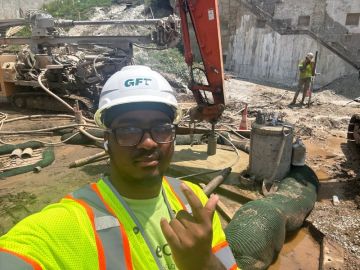Rocket Man: Widener Engineering Student Researches Ways to Improve Hypersonic Space Vehicles
Vinny Csercsevits ’25 spent his summer in Florida as part of a competitive research program funded by the U.S. Department of Defense and the National Science Foundation.

- School of Engineering
So how did you spend your summer vacation? It’s a question asked of many college students.
For Vinny Csercsevits ’25, the answer is pretty explosive. He worked on a research project to improve the structure of hypersonic vehicles, such as spacecrafts, satellites, and rockets, which could influence future manned and unmanned space missions.
The mechanical engineering major spent 10 weeks as part of the Research Experience for Undergraduates (REU) in Advanced Technologies for Hypersonic, Propulsive, Energetic, and Reusable platforms (HYPER), based at the University of Central Florida.
REU HYPER, a very long-titled, heavily-acronymic program, is jointly-funded by some big names — the U.S. Department of Defense and the National Science Foundation. The competitive program drew 16 students from across the country.
For Vinny, it unlocked a career interest with the likes of NASA or SpaceX.
Before doing this summer research experience, I didn’t really know what I wanted to do. I’ve been trying to narrow it down, and this has opened me up to aerospace engineering. I had never worked with anything like this before.” — Vinny Csercsevits ’25
Traditionally spacecrafts utilize sandwich structures in their design, which involve a honeycomb structure sandwiched between two metal sheets, providing a lightweight alternative to solid panels. But Vinny’s research team looked at replacing the honeycomb pattern with an origami-based structure that could compress, absorb energy, and withstand extreme forces, all while providing a safer, more light weight, and more fuel-efficient vehicle.
“We were trying to rethink the structures used in hypersonics, to make it safer and more efficient to fly these vehicles into space,” said Vinny. “We’re looking into the future. There’s the moon and Mars missions on the horizon. We are going to space a lot more.”
Vinny’s work was confined to the lab, not the launch pad. He used 3D printers to create and test the foldable origami structures, with samples made with thermoplastic polyurethane. “Our research more focused on testing the geometry,” he said.
Vinny was drawn to Widener by the size of the university, the engineering program, and the opportunity to do a co-op.
Vinny got that chance with Southco, a Concordville, Delaware County firm that designs and manufactures latches and hinges. There, he did CAD (computer-aided design) work, and believes the experience helped him land his placement in the REU HYPER program.
“There was a lot to build on at my co-op, and it probably helped me get this role,” he said.
Vinny also credits the support of Widener professors, including Associate Professor Kamran Fouladi, who shared the REU HYPER opportunity with Vinny and his fellow engineering students.
“The Widener faculty has always been really supportive,” said Vinny.
As Vinny begins his third year at Widener, he is eying research opportunities on campus and alongside professors.
“My next step is with them,” he said.
As for the REU HYPER program, Vinny presented a research poster on his work at the conclusion of the summer experience. He is also hoping to co-author a paper with graduate students working in the same lab at the University of Central Florida.



